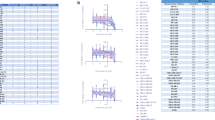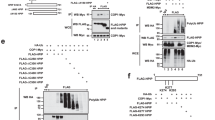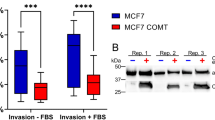Abstract
Augmented reactive oxygen species levels consequential to functional alteration of key mitochondrial attributes contribute to carcinogenesis, either directly via oxidative DNA damage infliction or indirectly via activation of oncogenic signaling cascades. We previously reported activation of a key oncogenic signaling cascade via mammalian target of rapamycin (mTOR) signaling complex-2 (mTORC2) owing to estrogen receptor (ER-α)-dependent augmentation of O2.− within the mitochondria of 17-β-estradiol (E2)-stimulated breast cancer cells. Manganese superoxide dismutase (MnSOD) is the principal mitochondrial attribute governing mitochondrial O2.− homeostasis, raising the possibility that its functional alteration could be instrumental in augmenting mitochondrial O2.− levels in breast cancer cells. Here we show ER-dependent transient inhibition of MnSOD catalytic function in breast cancer cells. Catalytic function of MnSOD is tightly regulated at the post-translational level. Post-translational modifications such as phosphorylation, nitration and acetylation represent key regulatory means governing the catalytic function of MnSOD. Acetylation at lysine-68 (K68) inhibits MnSOD catalytic activity and thus represents an important post-translational regulatory mechanism in human cells. Using reciprocal immunoprecipitation and proximity ligation assay, we demonstrate the occurrence of direct physical interaction between ER-α and MnSOD in human breast cancer cells, which in turn was associated with potentiated acetylation of MnSOD at K68. In addition, we also observed diminished interaction of MnSOD with sirtuin-3, the key mitochondrial deacetylase that deacetylates MnSOD at critical K68 and thereby activates it for scavenging O2.−. Consequently, compromised deacetylation of MnSOD at K68 leading to its inhibition and a resultant buildup of O2.− within the mitochondria culminated in the activation of mTORC2. In agreement with this, human breast cancer tissue specimen exhibited a positive correlation between acetyl-MnSODK68 levels and phospho-Ser2481 mTOR levels. In addition to exposing the crosstalk of ER-α with MnSOD post-translational regulatory mechanisms, these data also unravel a regulatory role of ER/MnSOD interaction as an important control switch for redox regulation of ER-α-responsive oncogenic signaling cascades. Furthermore, our study provides a mechanistic link for ER-α-dependent O2.− potentiation and resultant mTORC2 activation in breast cancer cells.
This is a preview of subscription content, access via your institution
Access options
Subscribe to this journal
Receive 50 print issues and online access
$259.00 per year
only $5.18 per issue
Buy this article
- Purchase on Springer Link
- Instant access to full article PDF
Prices may be subject to local taxes which are calculated during checkout






Similar content being viewed by others
References
Murphy MP . How mitochondria produce reactive oxygen species. Biochem J 2009; 417: 1–13.
Butterfield DA, Swomley AM, Sultana R . Amyloid beta-peptide (1–42)-induced oxidative stress in Alzheimer disease: importance in disease pathogenesis and progression. Antioxid Redox Signal 2013; 19: 823–835.
Domej W, Oettl K, Renner W . Oxidative stress and free radicals in COPD—implications and relevance for treatment. Int J Chron Obstruct Pulmon Dis 2014; 9: 1207–1224.
Yan MH, Wang X, Zhu X . Mitochondrial defects and oxidative stress in Alzheimer disease and Parkinson disease. Free Radic Biol Med 2013; 62: 90–101.
Klaunig JE, Kamendulis LM . The role of oxidative stress in carcinogenesis. Annu Rev Pharmacol Toxicol 2004; 44: 239–267.
Felty Q, Xiong WC, Sun D, Sarkar S, Singh KP, Parkash J et al. Estrogen-induced mitochondrial reactive oxygen species as signal-transducing messengers. Biochemistry 2005; 44: 6900–6909.
Kawanishi S, Hiraku Y, Oikawa S . Mechanism of guanine-specific DNA damage by oxidative stress and its role in carcinogenesis and aging. Mutat Res 2001; 488: 65–76.
Ogrunc M, Di Micco R, Liontos M, Bombardelli L, Mione M, Fumagalli M et al. Oncogene-induced reactive oxygen species fuel hyperproliferation and DNA damage response activation. Cell Death Differ 2014; 21: 998–1012.
Kumari Kanchan R, Tripathi C, Singh Baghel K, Kumar Dwivedi S, Kumar B, Sanyal S et al. Estrogen receptor potentiates mTORC2 signaling in breast cancer cells by upregulating superoxide anions. Free Radic Biol Med 2012; 53: 1929–1941.
Jacinto E, Loewith R, Schmidt A, Lin S, Ruegg MA, Hall A et al. Mammalian TOR complex 2 controls the actin cytoskeleton and is rapamycin insensitive. Nat Cell Biol 2004; 6: 1122–1128.
Quintela-Fandino M, Gonzalez-Martin A, Colomer R . Targeting cytoskeleton reorganisation as antimetastatic treatment. Clin Transl Oncol 2010; 12: 662–669.
Sarbassov DD, Ali SM, Sengupta S, Sheen JH, Hsu PP, Bagley AF et al. Prolonged rapamycin treatment inhibits mTORC2 assembly and Akt/PKB. Mol Cell 2006; 22: 159–168.
Spitz DR, Oberley LW . An assay for superoxide dismutase activity in mammalian tissue homogenates. Anal Biochem 1989; 179: 8–18.
Dhar SK, St Clair DK . Manganese superoxide dismutase regulation and cancer. Free Radic Biol Med 2012; 52: 2209–2222.
Oberley LW, Buettner GR . Role of superoxide dismutase in cancer: a review. Cancer Res 1979; 39: 1141–1149.
Yan T, Oberley LW, Zhong W, St Clair DK . Manganese-containing superoxide dismutase overexpression causes phenotypic reversion in SV40-transformed human lung fibroblasts. Cancer Res 1996; 56: 2864–2871.
Chen Y, Zhang J, Lin Y, Lei Q, Guan KL, Zhao S et al. Tumour suppressor SIRT3 deacetylates and activates manganese superoxide dismutase to scavenge ROS. EMBO Rep 2011; 12: 534–541.
Borgstahl GE, Parge HE, Hickey MJ, Beyer WF Jr, Hallewell RA, Tainer JA . The structure of human mitochondrial manganese superoxide dismutase reveals a novel tetrameric interface of two 4-helix bundles. Cell 1992; 71: 107–118.
Chen JQ, Eshete M, Alworth WL, Yager JD . Binding of MCF-7 cell mitochondrial proteins and recombinant human estrogen receptors alpha and beta to human mitochondrial DNA estrogen response elements. J Cell Biochem 2004; 93: 358–373.
Pedram A, Razandi M, Wallace DC, Levin ER . Functional estrogen receptors in the mitochondria of breast cancer cells. Mol Biol Cell 2006; 17: 2125–2137.
Finkel T, Deng CX, Mostoslavsky R . Recent progress in the biology and physiology of sirtuins. Nature 2009; 460: 587–591.
Lombard DB, Alt FW, Cheng HL, Bunkenborg J, Streeper RS, Mostoslavsky R et al. Mammalian Sir2 homolog SIRT3 regulates global mitochondrial lysine acetylation. Mol Cell Biol 2007; 27: 8807–8814.
Copp J, Manning G, Hunter T . TORC-specific phosphorylation of mammalian target of rapamycin (mTOR): phospho-Ser2481 is a marker for intact mTOR signaling complex 2. Cancer Res 2009; 69: 1821–1827.
Griendling KK, Sorescu D, Lassegue B, Ushio-Fukai M . Modulation of protein kinase activity and gene expression by reactive oxygen species and their role in vascular physiology and pathophysiology. Arterioscler Thromb Vasc Biol 2000; 20: 2175–2183.
Borrello S, De Leo ME, Galeotti T . Defective gene expression of MnSOD in cancer cells. Mol Aspects Med 1993; 14: 253–258.
Hayashi S-I, Eguchi H, Tanimoto K, Yoshida T, Omoto Y, Inoue A et al. The expression and function of estrogen receptor alpha and beta in human breast cancer and its clinical application. Endocr Relat Cancer 2003; 10: 193–202.
Buetler TM, Krauskopf A, Ruegg UT . Role of superoxide as a signaling molecule. News Physiol. Sci 2004; 19: 120–123.
Kanchan RK, Tripathi C, Baghel KS, Dwivedi SK, Kumar B, Sanyal S et al. Estrogen receptor potentiates mTORC2 signaling in breast cancer cells by upregulating superoxide anions. Free Radic Biol Med 2012; 53: 1929–1941.
Kim SC, Sprung R, Chen Y, Xu Y, Ball H, Pei J et al. Substrate and functional diversity of lysine acetylation revealed by a proteomics survey. Mol Cell 2006; 23: 607–618.
Scher MB, Vaquero A, Reinberg D . SirT3 is a nuclear NAD+-dependent histone deacetylase that translocates to the mitochondria upon cellular stress. Genes Dev 2007; 21: 920–928.
Stoica GE, Franke TF, Wellstein A, Czubayko F, List H-J, Reiter R et al. Estradiol rapidlyactivates Akt via the ERbB2 signaling pathway. Mol Endocrinol 2003; 15: 818–830.
Aykin-Burns N, Ahmad IM, Zhu Y, Oberley LW, Spitz DR . Increased levels of superoxide and H2O2 mediate the differential susceptibility of cancer cells versus normal cells to glucose deprivation. Biochem J 2009; 418: 29–37.
Oberley LW . Mechanism of the tumor suppressive effect of MnSOD overexpression. Biomed Pharmacother 2005; 59: 143–148.
Dwivedi SK, Singh N, Kumari R, Mishra JS, Tripathi S, Banerjee P et al. Bile acid receptor agonist GW4064 regulates PPARgamma coactivator-1alpha expression through estrogen receptor-related receptor alpha. Mol Endocrinol 2011; 25: 922–932.
Chen B, Caballero S, Seo S, Grant MB, Lewin AS . Delivery of antioxidant enzyme genes to protect against ischemia/reperfusion-induced injury to retinal microvasculature. Invest Ophthalmol Vis Sci 2009; 50: 5587–5595.
Misra HP, Fridovich I . The generation of superoxide radical during the autoxidation of hemoglobin. J Biol Chem 1972; 247: 6960–6962.
Acknowledgements
We thank the Director of CDRI for providing the facility and infrastructure. We also thank Dr Kalyan Mitra and Dr Kavita Singh (SAIF) for providing microscopy facilities and Dr AL Vishwakarma (SAIF) for providing flow cytometry facilities. The financial grants received for this study were SR/FT/LS-169/2012 from DST and No. BSC0103 from CSIR India. Mehraj u din alone received fellowship from the Indian Council of Medical Research, New Delhi under ICMR-JRF scheme vide award letter no. 3/1/3/JRF-2011/HRD-69(12035). The institutional manuscript no. for this article is 9324.
Author information
Authors and Affiliations
Corresponding author
Ethics declarations
Competing interests
The authors declare no conflict of interest.
Additional information
Supplementary Information accompanies this paper on the Oncogene website
Supplementary information
Rights and permissions
About this article
Cite this article
Lone, MUD., Baghel, K., Kanchan, R. et al. Physical interaction of estrogen receptor with MnSOD: implication in mitochondrial O2.− upregulation and mTORC2 potentiation in estrogen-responsive breast cancer cells. Oncogene 36, 1829–1839 (2017). https://doi.org/10.1038/onc.2016.346
Received:
Revised:
Accepted:
Published:
Issue Date:
DOI: https://doi.org/10.1038/onc.2016.346



